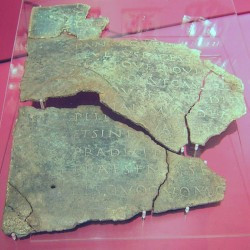Jona Lendering
Jona Lendering read history at Leiden University (MA 1993), specialized in Mediterranean culture at the Amsterdam Free University (MA 1996), and worked at excavations in Holland (Riethoven) and Greece (Halos). After teaching historical theory and ancient history at the Free University for several years, he was one of the founders of a school for history teaching, Livius Onderwijs. Born in Amsterdam, it has now spread to auxiliary locations in Bussum, Dronten, Gouda, Haarlem, Hoorn, Schagen, Zaanstad, and Zoetermeer. As of 2013, Livius Onderwijs has eight teachers, about 500-600 students a year, and offers tours to countries like Italy, Turkey, Iran, and Lebanon. The field trips help to etch into the students' minds some of what they've learned at the school.
Because history is for a large part telling a story, something you do best in your own language, Lendering prefers to publish in Dutch journals. However, he has contributed to the Bryn Mawr Classical Review and Ancient Warfare, while he is the founder of Ancient History Magazine. He is also the publisher and editor of the on-line publication of the Babylonian Chronicles of the Hellenistic Period, a set of important cuneiform sources for the history of the Seleucid and Parthian Near East, transcribed, translated and commented on by Bert van der Spek of the Free University Amsterdam and Irving Finkel of the British Museum. A publication as book is in preparation.
Lendering has written several books and maintains a blog in Dutch. He is the author of several books, including Edge of Empire and Consensus and Crises. For the Livius website, which has received several awards, he collaborates closely with Bill Thayer of LacusCurtius. Lendering is also the webmaster of two daily blogs, the MainzerBeobachter.com and Grondslagen.net.
There are 9380 items in Jona Lendering:

Leersum, The Tabula Leersumiana |
Leeuwarden, Fries Museum
The Fries Museum is not primarily focused on ancient history or art, but it has a collection of archaeological finds. There are 4 items in Leeuwarden, Fries Museum: …Legio I Adiutrix
Legio I Adiutrix: one of the Roman legions. Its name means "helper" or "assistant". Nero The legion was formed in 68, but…Legio I Armeniaca
Legio I Armeniaca: one of the legions of the later Roman empire. Its name means "the Armenian legion". Julian the Apostate This…Legio I Flavia Constantia
Legio I Flavia Constantia: one of the legions of the later Roman empire. Its name means "the reliable Flavian legion". Constantius…Legio I Flavia Gallicana Constantia
Legio I Flavia Gallicana Constantia: one of the legions of the later Roman empire. Its name means "the reliable Flavian legion from Gaul". …Legio I Flavia Martis
Legio I Flavia Martis: one of the legions of the later Roman empire. Its name means "the Flavian legion, dedicated to Mars". …Legio I Flavia Pacis
Legio I Flavia Pacis: one of the legions of the later Roman empire. Its name means "the Flavian legion of peace". …Legio I Germanica
Legio I Germanica: one of the Roman legions. It owes its name to the fact that it served in the Germanic wars. …Legio I Illyricorum
Legio I Illyricorum: one of the legions of the later Roman empire. Its name means "legion of the Illyrians". Coin of…Legio I Iovia
Legio I Iovia: one of the legions of the later Roman empire. Its name means "the legion dedicated to Jupiter". Diocletian This…Legio I Isaura Sagittaria
Legio I Isaura Sagittaria: one of the legions of the later Roman empire. Its name means "the first Isaurian legion of archers". …